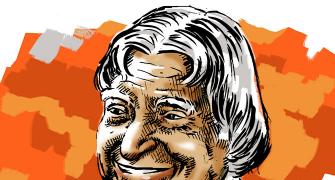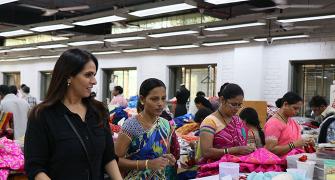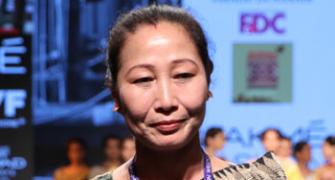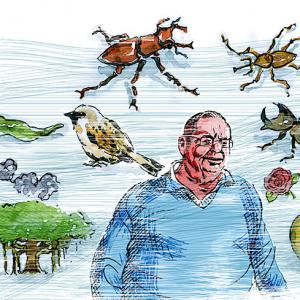Martand Singh, the master of weaves, took India to the world, notes Ritika Kochhar.
Illustration: Dominic Xavier/Rediff.com
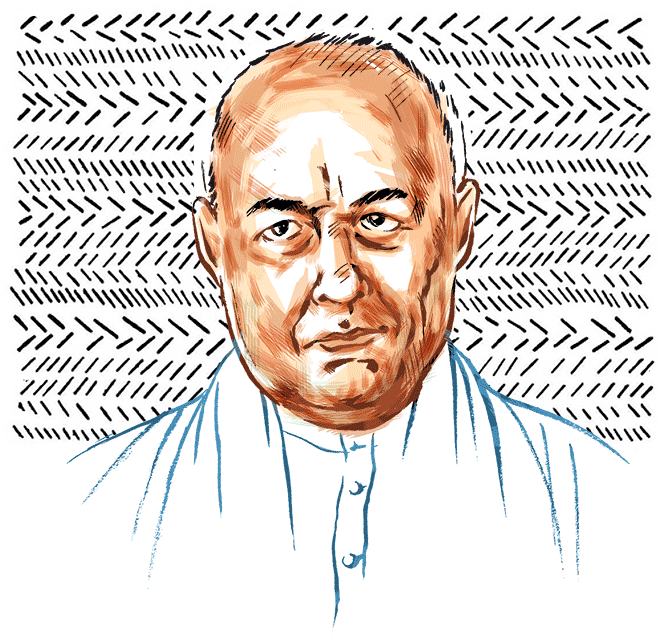
Design curator and writer Mayank Mansingh Kaul says Martand Singh 'Mapu' was foundational to his work. "For my generation, his work was the benchmark that brought the rigour of thorough research and expert execution together, with great imaginative and creative leaps," he says.
It's hard to think of national icons outside politics, movies and sports, but in the passing of Singh, there is an outpouring of grief from the art and fashion fraternity.
From the 1980s to the 1990s, he was India's leading exponent of textiles, and he shaped notions of contemporary India within the country as well as abroad, much like his mentor, Pupul Jayakar, before him.
"Mapu was brilliant at finding varying degrees of excellence and creating a coherent statement of where art stood," says Rajeev Sethi, the other inheritor of Jayakar's vision.
Singh, Sethi says, brought together the Weavers Service Centres that were started by Jayakar across the country in the 1950s and created a coherent statement documenting textiles and weaves across the country.
In 1982, the Vishwakarma Exhibition that went to Britain as part of the Festival of India brought together these efforts from almost every state.
"His chutzpah and eye for quality made Vishwakarma a rallying point to reintroduce amazing creations like the patola, kanjeevarams and ghar cholas," Sethi recalls.
Sethi first met him in college where they were both studying history. "He was a year senior to me. He extricated me from being ragged and took me up to his room in the hostel. I still remember that he lounged in this carved cane chair and his lamp was covered with scarves, which was so unusual for a hostel room."
After college, Goody Oberoi gave Singh, Naveen Patnaik and Mahijeet Jhala a space within the Oberoi Hotel to open a boutique they called Psychadelhi and where they created bespoke couture like leather pants and capes with peacock feathers.
He left it to join Jayakar in The Handlooms & Handicrafts Export Corporation of India. He headed the Calico Museum in Ahmedabad for a while.
And in the 1980s, he moved to Delhi where, after the success of Vishwakarma, he helped found the Indian National Trust of Art and Heritage on the lines of the National Trust of Britain.
"He was an extremely capable administrator. Jayakar would often say that Sethi, the artist, and Mapu, with his ability to get things done, are my two hands. Now, if only they could get along," says Sethi.
Sethi says both were always uncomfortable with the way they were pitched as rivals.
"I always envied him his sense of organisation and his administrative abilities. He could make you laugh till you were rolling on the floor, but he found ways to communicate the creative process, and his ability to position things was magical."
Singh, Sethi adds, was also very astute in understanding trends and had a clear-sighted view of what made India 'India.'
"And he had the correct idea of getting the right stakeholders for INTACH, like the royal families."
The royal families were a natural preference for Singh. His mother, Sita Devi of Kapurthala, was known as the 'Pearl of India' in her youth, and, as he wrote in the book, Maharanis: Women of Royal India, was friends with Maharani Gayatri Devi and Princess Durru Shehvar of Berar.
He also put together an exhibition in 1985 on the costumes of royal India with Diana Vreeland that travelled to the Met Museum in New York.
"I still remember when he came to see me in Paris in 1969 to ask me to collaborate on a fashion show to be held in America. I'd never seen a car so big. It was owned by the Woolworth's heiress who was a family friend of his," recalls Sethi.
'I was 13 or 14 when I first saw him in 1960. Mapu was extra special and we all gawked out of the dorm windows at his fey beauty,' Laila Tyabji wrote in a social media post.
She collaborated with him in the 1970s on various interior design projects, and later shared offices when he moved back to Delhi.
He was then writing and editing the Amar Vastra Kosh series of books that included Saris of India and Handcrafted Indian Textiles, on which he worked with Rita Kapur Chishti and Rahul Jain.
'He had morphed into an elegant, fastidious textile guru and aesthete. Blue jeans had been abandoned for beautifully tailored white khadi kurta-pyjamas, a 400 count muslin angavastra or shahtoosh shawl draped over his shoulder, setting a fashion of ethnic chic much copied by Delhi's cultural elite,' Tyabji remembered.
He became the soul and vision behind INTACH as well at this time.
As the first secretary of the trust, along with B K Thapar, he created a holistic vision of conservation that included the protection of the environment as well as material and tangible heritage and also set up the 122 chapter offices at the district level to ensure that the effort reached the grassroots.
Among their earliest projects was the conservation of the town and textiles of Chanderi.
Fellow founder A G K Menon and he worked on the Varanasi ghats, where the government was planning a World-Bank-funded promenade.
"We were able to persuade the government that it was important to consult the people who used the ghats. We even built an electric crematorium and made the burning ghats more efficient," says Menon.
"In all, we completed a Rs 100 crore project in Rs 3 crore or Rs 4 crore. And we preserved and brought back meaning to our heritage."
Singh retired to Mussoorie in the last decade where he focused on textiles and jewellery, but textile designers from every generation remember him as much for his great sense of humour and unconditional love as his work.
"It is important to remember that, at a time when Indian art was only beginning to emerge in its nascent stage, his work showed the way for curatorial questions in textiles," says Kaul.
"Thus, for us, his work remains the only example of how research, scholarship and design practice could come together for public projects."
MUST READ features in the RELATED LINKS BELOW...


